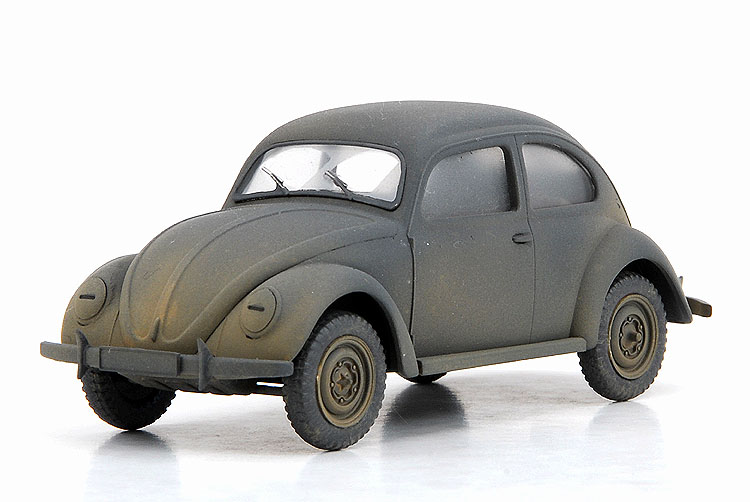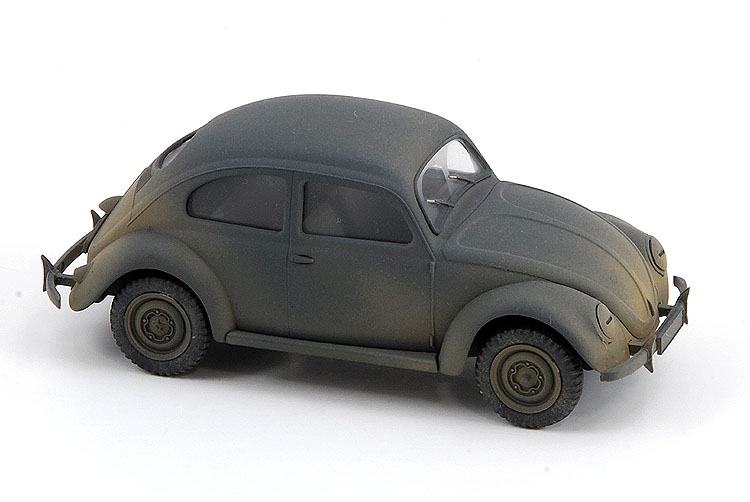

Isn't it cute? In 1/48th scale the KdF-Wagen is barely any bigger than a Hot Wheels car.
Kit:
Aftermarket:
Date:
Tamiya (32531)
None
2009
Don’t call it a Beetle. It may look like Herbie the Love Bug, or the rust bucket you drove in college, but this one was an instrument of war.
In 1933, Adolf Hitler proposed a “Volks-Wagen” (that translates to People’s Car). It would carry two adults and three children at 100km/h, it would be reliable, and affordable
enough so everyone in Germany could own one. At 990 Reichsmarks, it would have a sale price comparable to a motorcycle. To accomplish this plan, German citizens could purchase
stamps in a booklet. When all the stamps were collected, you’d saved enough for a car.
Ferdinand Porsche had developed a simple automobile several years before, and sensing its suitability, dusted off the design (and prototypes). Where the idea was sound back in
1931, it wasn’t financially practical to produce such a car. Hilter’s Volks-Wagen plan made production viable. The whole city of Stadt des Kdf-Wagens was constructed in Lower
Saxony in 1938 (at a cost of $50-million) to house workers. A factory was built to produce cars for the civilian market, but war was declared before a single example had been
completed. Wartime production was strictly for the military although certain members of the Nazi elite received cars.
Porsche originally called his design the Porsche 60, but it received the official name of KdF-Wagen. That’s Kraft durch Freude, or Strength Through Joy, the name of the official
leisure organization of the Third Reich. Don’t you wish modern cars had such names?
Equipped with an air-cooled, rear mounted 25hp engine, the design was simplicity itself, and lent itself to modifications. Early production was of the Typ 82 Kubelwagen, and the
amphibious Typ 166 Schwimmwagen. The basic 2WD model was the Typ 82, looking very similar to the famous Beetle. The 4WD model was the Typ 86. A 4WD model with an off-road chassis
became the Typ 87. The SS had its own special version called the Typ 92. It could be either 2WD or 4WD. Production never reached the factory’s potential, usually only about
20-25% of capacity, and never more than 50%.
KdF-Wagens were popular staff cars for mid-ranking officers. Senior officers warranted fancier automobiles “borrowed” from the civil population, but compared to the alternative
means of transportation, mid and junior officers appreciated the dry and heated little car.
Production halted in 1945 following a bombing raid, but by this time most of the production facilities had been moved into underground storage bunkers, so production could resume
after the war. When production resumed in 1947, it was an immediate success. Licensed production was done in Australia, Brazil, Indonesia, Ireland, Mexico, Nigeria, South Africa
and Thailand. The last VW Beetle rolled off its Mexico production line on June 30, 2003, number 21,529,464.
Remember the people the Volks-Wagen was originally intended for, those sticker collecting car buyers? When the Russians overran Berlin in 1945 the KdF fund had $67-million saved
in various banks.
My plan called for a diorama to display my Tamiya Storch. Naturally I wanted something to accompany my plane to give it a sense of scale and story. Not knowing much about German
support vehicles, I wasn’t sure if a KdF-Wagen would even be a suitable for my plans. It took some searching on the internet to discover that it would indeed work. Wanting
something different, especially if I take my diorama to a show, I opted for the KdF-Wagen over the more traditional, more military looking Kublewagen.
Number 31, in Tamiya’s growing line of 1/48th scale armour subjects, the Typ 82 fits right along side their Typ 82 Kubelwagen, Citroen 11CV and 1942 Ford staff cars.
Moulded in tan plastic it’s a simple, but effectively detailed kit. The body is one piece. The clear windows the sides and rear windows are one piece. The front windshield is
separate. A nice touch is that the wheel rims are included as separate inserts, making painting of the tires easier. The Beetle’s famous domed hubcaps are offered as an option.
The hood can be opened, but there’s nothing inside to look at, and the trunk is moulded closed, which is just as well, since there’s no engine to look at either. A driver figure
is offered, as are markings for three subjects, including an all-black civilian model.
Without a lot of experience building cars and armour models, I decided to follow the instructions pretty close. Naturally there are some areas where you can deviate, but with so
few parts, it was mostly choosing what subassemblies I wanted to make to simplify painting.
All the small parts were cleaned up and attached, either to the body, or the chassis. The suspension, exhaust, wheels, bumpers and front seats were left off. Speaking of the
seats, Tamiya left the backside of all three seats open. I filled these by gluing sheet styrene across the back. Once dry, they were trimmed and sanded to match the seat’s
profile.
The worst part of the build was getting some of these really small pieces in place. Take the headlights for example. I carefully removed them from the sprue and cleaned up the
sprue gate, only to discover that Tamiya compensated for this with a notch in both the body, and the headlight cup.
It was only after I’d glued the lights in position that I remembered the body’s mould lines. Using sanding sticks and sand paper, I removed them and polished the plastic. That’s a
common problem I have with these quick models, they go so fast I forget basics – like seam lines. Thankfully I hadn’t applied paint before I remembered about them.
A small gap between the hood and the body was dressed using Krystal Kleer. It was dabbed along the gap, given a couple minutes to set up then wiped away with a moistened cotton
swab. The gap wasn’t completely filled, nor should it have been. I still needed the joint to indicate the separation between hood and body.
To simplify the painting stages, I left the body off the chassis and the windows out of the body.
According to a discussion on the Missing-Lynx armour website, wartime colours for KdF-Wagens were quite limited; the Nazi elite drove shiny black ones, while the military had
either drab Panzer Grey or drab Dark Yellow. A small number were painted differently for experimental or propaganda reasons. It was also pointed out that no photographic evidence
points towards KdF-Wagens being used by the Afrika Corps, although some seem interested in this scheme.
Knowing that my KdF-Wagen was going to accompany my Fieseler Storch in a European diorama, I opted for the more subdued Panzer grey.
The first step was to spray the whole car with Polly Scale RLM Night Black. I then applied Model Master Acryl Panzer Grey, leaving the black faintly visible in the corners and
crevasses.
The interior was painted overall black. Although Tamiya called for dark tan I thought this would be out of place on a grey car. Instead, I painted the seats with a medium-dark
grey paint I had laying on my modelling bench.
I didn’t go crazy dirtying up my little staff car. Let’s assume someone washed it not to long ago. Or maybe there was a good rainstorm in the past week or two. I think it’s just
dirty enough to blend it into the diorama it’ll eventually be part of.
Not knowing how a VW weathered, and since all the photos online show clean show cars, I asked my neighbour, who was really into VW Beetles. He presented me with a photo of a
really dirty off road Beetle – a perfect reference. I applied some light dust with Polly Scale US TAC tan (a Vietnam War camouflage colour). Heavily thinned black acrylic was
applied into the engine cooling grill. Using RAF Dark Earth brown, I applied mud stains to the tires using a small piece of sponge.
The final step, after the windows were glued into place and the body attached to the chassis, was to cut a small masking tape donut and mask off the wiper path on the front
windshield. A light spray with Polly Scale clear flat finished everything and made the windows appear dusty.
In 1/48th scale the KdF-Wagen is small. Let’s face it; it’s about the same size as the Hot Wheels car you played with as a kid. It’s not a glamorous subject but it is an
interesting one, and one ideally suited for a lot of Second World War model collections.
I think the greatest joy I’ve gotten from this model has come from just holding it in the palm of my hand and chuckling about how cute it is.
